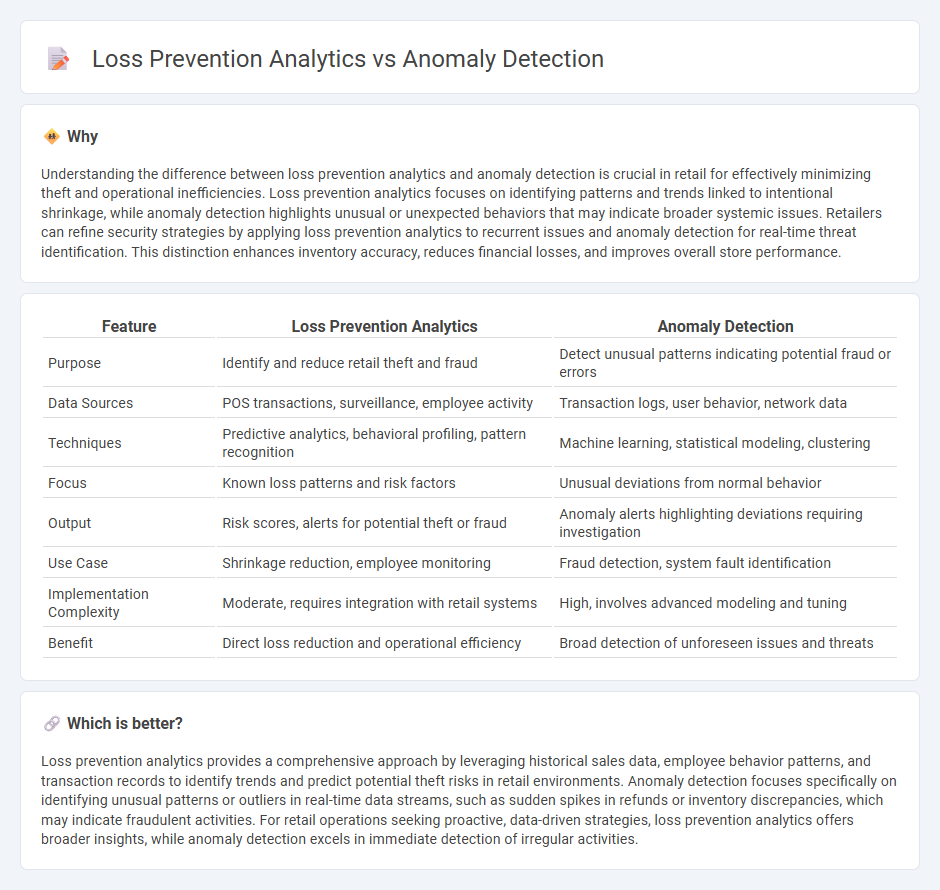
Loss prevention analytics leverages data-driven insights to identify patterns of theft and inventory shrinkage within retail environments, optimizing store security and operational efficiency. Anomaly detection focuses on pinpointing unusual transactions or behaviors that deviate from established norms, providing real-time alerts to prevent fraudulent activities. Explore the differences and advantages of these techniques to enhance retail loss prevention strategies.
Why it is important
Understanding the difference between loss prevention analytics and anomaly detection is crucial in retail for effectively minimizing theft and operational inefficiencies. Loss prevention analytics focuses on identifying patterns and trends linked to intentional shrinkage, while anomaly detection highlights unusual or unexpected behaviors that may indicate broader systemic issues. Retailers can refine security strategies by applying loss prevention analytics to recurrent issues and anomaly detection for real-time threat identification. This distinction enhances inventory accuracy, reduces financial losses, and improves overall store performance.
Comparison Table
| Feature | Loss Prevention Analytics | Anomaly Detection |
|---|---|---|
| Purpose | Identify and reduce retail theft and fraud | Detect unusual patterns indicating potential fraud or errors |
| Data Sources | POS transactions, surveillance, employee activity | Transaction logs, user behavior, network data |
| Techniques | Predictive analytics, behavioral profiling, pattern recognition | Machine learning, statistical modeling, clustering |
| Focus | Known loss patterns and risk factors | Unusual deviations from normal behavior |
| Output | Risk scores, alerts for potential theft or fraud | Anomaly alerts highlighting deviations requiring investigation |
| Use Case | Shrinkage reduction, employee monitoring | Fraud detection, system fault identification |
| Implementation Complexity | Moderate, requires integration with retail systems | High, involves advanced modeling and tuning |
| Benefit | Direct loss reduction and operational efficiency | Broad detection of unforeseen issues and threats |
Which is better?
Loss prevention analytics provides a comprehensive approach by leveraging historical sales data, employee behavior patterns, and transaction records to identify trends and predict potential theft risks in retail environments. Anomaly detection focuses specifically on identifying unusual patterns or outliers in real-time data streams, such as sudden spikes in refunds or inventory discrepancies, which may indicate fraudulent activities. For retail operations seeking proactive, data-driven strategies, loss prevention analytics offers broader insights, while anomaly detection excels in immediate detection of irregular activities.
Connection
Loss prevention analytics leverages data-driven techniques to identify patterns indicating potential theft, fraud, or operational inefficiencies in retail environments. Anomaly detection plays a crucial role by automatically spotting deviations from normal transaction behaviors or inventory movements, enabling early warnings of suspicious activities. Integrating these methods enhances retailers' ability to reduce shrinkage and improve overall security through more precise and timely interventions.
Key Terms
Outlier Identification
Anomaly detection focuses on identifying patterns in data that deviate significantly from the norm, which is essential for early detection of unusual or suspicious activities. Loss prevention analytics leverages these insights to proactively minimize financial losses by promptly addressing detected outliers that may indicate fraud, theft, or operational inefficiencies. Explore more about how these technologies transform risk management and operational strategies.
Shrinkage Analysis
Anomaly detection identifies unusual patterns in shrinkage data by analyzing deviations from expected inventory levels, while loss prevention analytics focuses on pinpointing root causes such as theft, fraud, or operational inefficiencies to mitigate financial losses. Shrinkage analysis integrates both approaches to provide comprehensive insights that optimize inventory management and reduce store losses. Explore detailed strategies on how combining anomaly detection with loss prevention analytics can significantly enhance shrinkage control.
Root Cause Analysis
Anomaly detection identifies unusual patterns or deviations in data that may indicate potential issues, while loss prevention analytics emphasizes understanding and mitigating financial losses by pinpointing root causes. Root Cause Analysis within loss prevention leverages anomaly detection outputs to trace underlying factors such as process failures, fraud, or operational inefficiencies. Explore further to understand how integrating these methodologies enhances risk management and decision-making effectiveness.
Source and External Links
Anomaly detection - Wikipedia - Anomaly detection, also known as outlier detection or novelty detection, is the identification of rare items or events that differ significantly from the norm, with techniques including neural networks (autoencoders, CNNs), clustering, and ensemble methods for various types of data.
Anomaly Detection Techniques: How to Uncover Risks ... - Anomaly detection refers to identifying data points or patterns that deviate significantly from expected behavior, using statistical, machine learning, and deep learning methods suited for different data complexities and scenarios.
What Is Anomaly Detection? | IBM - Anomaly detection identifies observations or data points that deviate from the expected, often leveraging AI and ML to detect rare anomalies that could signal fraud, defects, cybersecurity threats, or clinically abnormal conditions across industries.
 dowidth.com
dowidth.com